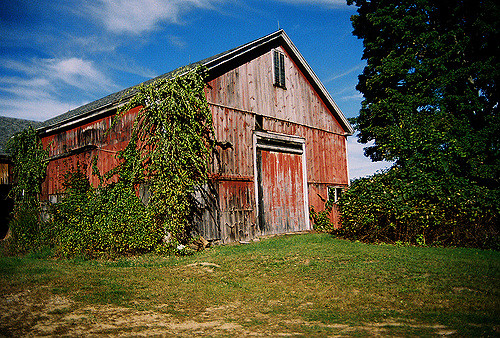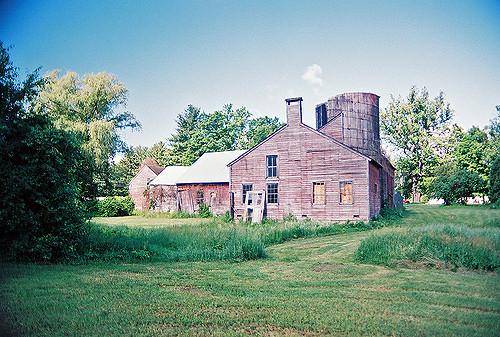Preserving Barns and Rural Landscapes
By Michele Barker, Western Massachusetts Circuit Rider, Preservation Massachusetts
 As the song goes, "June is bustin' out all over..." When I look over the list of projects I've dealt with as Circuit Rider for Western Massachusetts, however, I'm tempted to change those lyrics to "Barns are fallin' down all over..." About 15-20% of the projects I've seen over the past year have involved barns in varying stages of disrepair, which (to continue the Rodgers & Hammerstein theme) can often be "a puzzlement."
As the song goes, "June is bustin' out all over..." When I look over the list of projects I've dealt with as Circuit Rider for Western Massachusetts, however, I'm tempted to change those lyrics to "Barns are fallin' down all over..." About 15-20% of the projects I've seen over the past year have involved barns in varying stages of disrepair, which (to continue the Rodgers & Hammerstein theme) can often be "a puzzlement."
From 18th-century English barns with silvery-gray weathered siding, to rambling Dutch-gabled dairy barns of the late 19th and early 20th centuries, to massive Connecticut River Valley tobacco barns with their swinging-plank ventilation systems, Massachusetts barns are a quintessential part of our New England landscape. Unfortunately, many are becoming part of that landscape in an all-too-literal way. Swaybacked and foundered like a plowhorse worked beyond its prime, they slump off their foundations or slowly crumble to the earth.
After decades of neglect, these massive buildings can be massively expensive to renovate. Farmers seeking to preserve their historic barns can sometimes tap USDA or Massachusetts Department of Agriculture resources or state and federal historic tax credits, though the tax credit application process can be daunting. Ironically, programs designed to protect agricultural land often provide no protection for the buildings that reflect the essence of the land's agricultural history, and sometimes even regard barns as liabilities to be removed.
Barns that are no longer used for farming are a tricky proposition. It can be frustrating to meet homeowners seeking to rehabilitate their historic barns and have no funding resources to offer them. Towns with Community Preservation Act funds have a definite advantage when dealing with endangered agricultural buildings, and can get a two-for-one benefit by combining open space and historic preservation in one project. For example, the Southwick Historical Society recently obtained CPA funding to relocate a barn that once housed a cigar factory, a rare structure documenting both agriculture and rural industry in the Connecticut River Valley. The Society hopes to use the building for artifact storage and interpretive programming.
 Preservation Massachusetts’ Barn Task Force and the National Trust for Historic Preservation’s Barn Again! program have worked hard to promote old barns as assets, not eyesores. The number of calls we Circuit Riders have received about barns indicates that the word is getting out. Issues have ranged from centuries-old family farms struggling to maintain their historic homes, barns, and fields to historical societies wanting to preserve a town's agricultural heritage, to homeowners who simply love the massive timber-frame buildings. These barn advocates admire not only the craftsmanship involved in the buildings' construction, but also the daily backbreaking labor of tending crops and livestock that went on (and in some cases continues) in and around these buildings.
Preservation Massachusetts’ Barn Task Force and the National Trust for Historic Preservation’s Barn Again! program have worked hard to promote old barns as assets, not eyesores. The number of calls we Circuit Riders have received about barns indicates that the word is getting out. Issues have ranged from centuries-old family farms struggling to maintain their historic homes, barns, and fields to historical societies wanting to preserve a town's agricultural heritage, to homeowners who simply love the massive timber-frame buildings. These barn advocates admire not only the craftsmanship involved in the buildings' construction, but also the daily backbreaking labor of tending crops and livestock that went on (and in some cases continues) in and around these buildings.
Although barn preservation is a challenge, there are encouraging signs. Some land conservation organizations are recognizing that historic preservation and land preservation can complement each other. In Plainfield, the Franklin Land Trust is raising funds to rehabilitate an early 19th-century English barn for interpretive programming and events.
In their turn, historical organizations can use barns as a tool to reach out to environmental and agricultural organizations. The Great Barrington Historical Society acquired a unique collection of 18th and 19th century barns and outbuildings along with the 18th century Truman Wheeler House, and hopes to incorporate them into a site involving historic, environmental, and agricultural programming.
You can help us Circuit Riders and PM's Barn Task Force by pointing us to model projects - from barns that have been well-maintained over the decades to barns that have been saved from the brink of disaster. Keep us informed about rehabilitated barns that have continued in agricultural use and those that have been converted to new residential, commercial, or nonprofit uses. We're keen to find innovative projects and creative fundraising ideas that can serve as inspirations and models for barn owners. We'd especially like to hear about barn renovations that have used historic preservation tax credits. You can also encourage contractors who've done great barn projects to sign on to our Consultants' Directory so we can spread the good word about their good work. And, most important, continue to sing the praises of barns in your community. Maybe some day our Barn Task Force can say, "Barns are lookin' great all over..."
The current Circuit Rider for Western Massachusetts is Stacia Caplanson. She can be reached at scaplanson@preservationmass.org. The Massachusetts Circuit Rider Program is a partnership of Preservation Massachusetts and The National Trust for Historic Preservation.
July 2009

